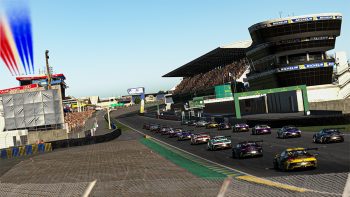
Fixed Setups and iRacing: Empowering Your Inner Driver or Frustrating Your Inner Engineer?
August 4th, 2010 by DavidP
When iRacing unveiled the 2010 Season 3 schedule they also announced the addition of two new fixed-setup series — both of these fixed-setup series will be B-Class series, featuring the C6.R Corvette on the road course side, and the Impala SS Class B on the oval side. These new fixed-setup series will run in addition to the existing open (adjustable) setup iRacing GT Championship and NASCAR iRacing Class B series on the same schedule but with race distances set at 50% of the adjustable setup events.

Fixed setups are nothing new to iRacing . . .
Fixed setups are nothing new to iRacing — every member initially stated out in fixed-setup series: The Rookie Legends on the oval side is a fixed-setup series, and the Rookie Solstice on the road racing side is also a fixed-setup series. Moving up the iRacing license ranks, the Volkswagen Jetta TDI Cup is a fixed-setup road racing series that runs at the D-Class, and while the Skip Barber Race Series doesn’t qualify as a true “fixed-setup” series, the Formula Skip Barber 2000 cars features a very limited number of setup adjustments, including tire pressure, fuel load, front ride height (spring perch settings), brake bias, and rear anti-roll bar setting, which positions it very close to the fixed-setup end of the spectrum.
Given all of this, you would think that the addition of two fixed-setup series at the B-Class level wouldn’t be a big deal — in fact, on the oval side, the addition of the fixed-setup Class-B series means there will be more opportunities to race in that car. These new fixed-setup series offer a different set of challenges than the open (adjustable) setup series, and should encourage more people to try racing in these series thanks to the level playing field provided by the option of racing in a fixed-setup series without having to worry about trying to become a race engineer on top of having to learn the cars and tracks.
Still, despite all this, I’ve seen a lot of offhand comments in the iRacing member forums indicating that fixed setup racing is going to take away a significant aspect of realism here at iRacing . . . but I’m not so sure.
I think the issue of how you as an individual driver is going to be impacted by the prospect of being “forced” to race in a fixed-setup series has a lot to do with whether you primarily think of yourself as a driver or as a race engineer.
Consider what it means being a race driver in the real world, especially among the professional ranks — I’m sure a lot of drivers often find themselves “at the mercy” of their race engineer because they provide feedback to the engineer, the engineer dials-in settings, the mechanics do their thing, and then the driver has to go out and try to drive whatever concoction the engineer and mechanics have thrown together.
There's no blaming your inner engineer when this happens with a fixed setup!
In many ways, this is one crucial area where sim racing differs from how it really is in the real world — a lot of good drivers understand what works, but even the best drivers today typically aren’t the ones turning the wrenches, or analyzing the telemetry data. It takes a good driver/engineer combo to establish the necessary rapport required to give and receive good feedback in order to produce positive results, and it sometimes takes a team of mechanics a significant amount of time to make the necessary changes (stuff that we accomplish with a few simple clicks in a menu).
Just consider that the fixed setup races are roughly equal to moving to a new team in the real-world, with a race engineer with whom you’re not familiar. Fixed setups are kind of like if you were picked-up by a big team to fill-in for an injured driver — the team would give you a car that was setup to perform in a relatively predictable manner; it would have a decent setup, but it wouldn’t be dialed-in and fully-tweaked to match your preferences and your driving style.
When it comes down to those fully dialed-in, “personalized” setups in the real world, they only come from long-term relationships between drivers and engineers who work well and closely over time. Drivers who are given setups that “should” work and then asked to jump in a car and go fast and compete is probably closer to the norm in the real world, and we sim racers are quite spoiled by being able to be our own drivers, race engineers and mechanics — this just doesn’t happen all that much in the real world, where things that we would consider “fixed setups” are much closer to the norm.
With all of this in mind, the prospect of fixed-setup racing really only impacts our “inner engineer” — the driver within still has a car to master, and a track to tame. Keep that in mind — and keep an open mind — and fixed setup racing begins to seem a lot less “unrealistic.”


















































